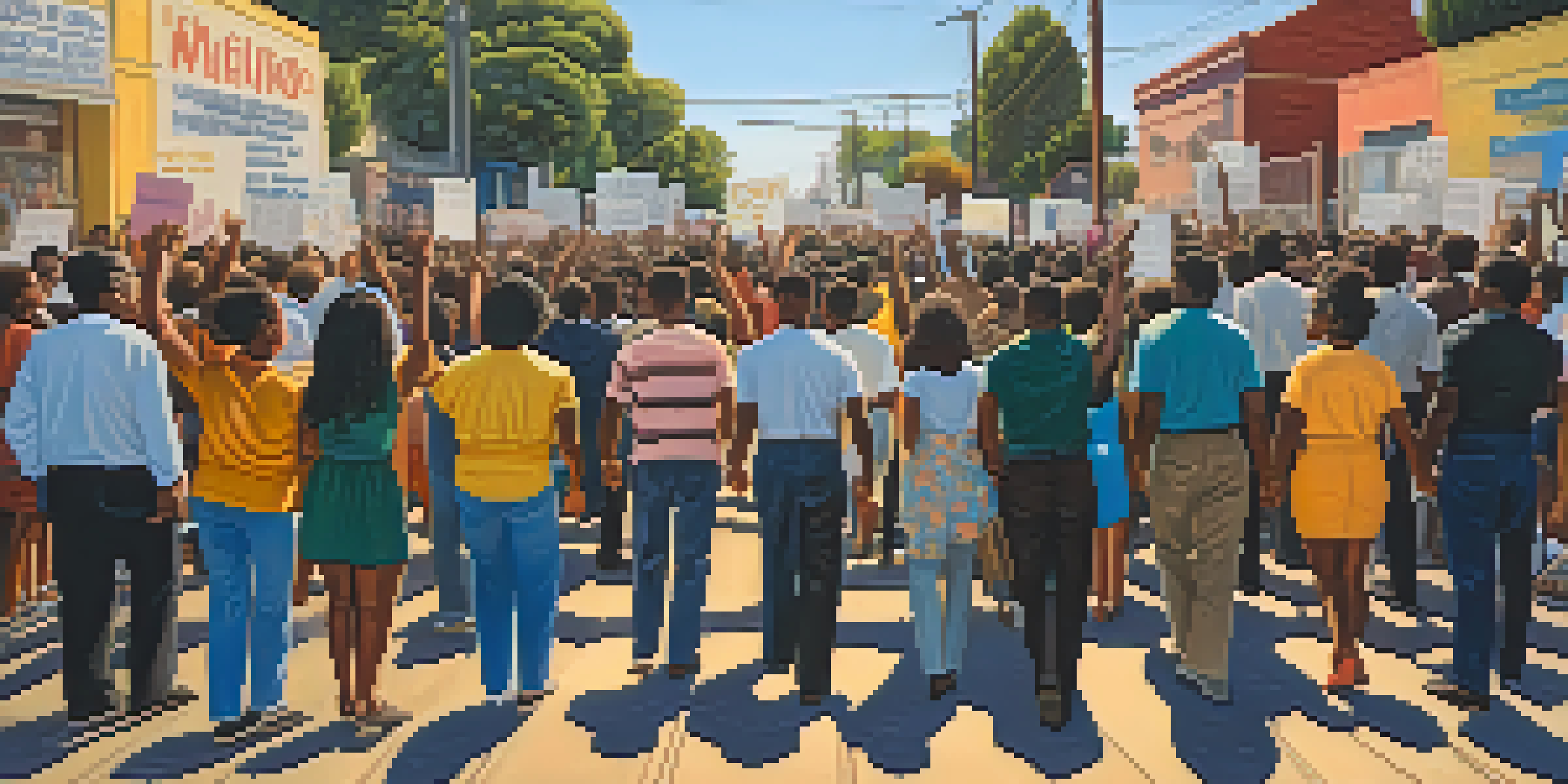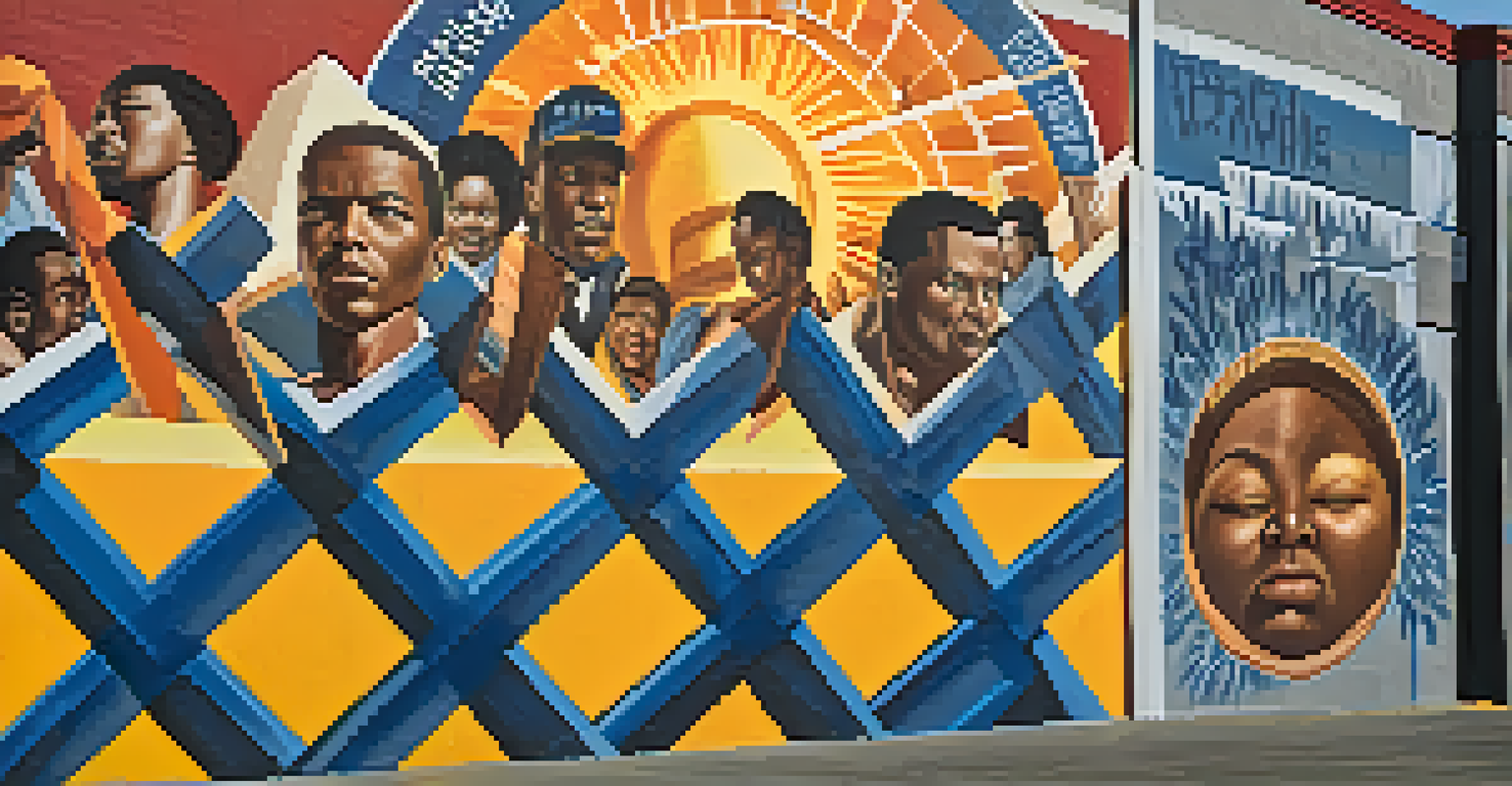The 1965 Watts Riots: Understanding Its Historical Impact

Overview of the Watts Riots: A Brief Introduction
The Watts Riots, which erupted in August 1965 in Los Angeles, were a significant event in American history. Triggered by an incident of police brutality, this uprising lasted six days and resulted in widespread violence and destruction. The riots highlighted deep-seated racial tensions and socioeconomic disparities that had been festering in the community for years. Understanding these riots is crucial, as they reflect the struggles faced by African Americans in the 1960s and their fight for civil rights.
Riot is the language of the unheard.
The Watts neighborhood, predominantly African American, was already grappling with poverty, unemployment, and inadequate housing. These underlying issues created a perfect storm for unrest when the police arrested a young black man, Marquette Frye, after a traffic stop. In the aftermath, tensions escalated rapidly, and what began as a small confrontation spiraled into a full-blown riot. The unrest not only shocked the nation but also served as a wake-up call regarding systemic racism and injustice.
Ultimately, the Watts Riots were more than just a response to a single event; they symbolized the frustrations of an entire community. With thousands of people taking to the streets, the riots became a catalyst for change, sparking discussions about racial equality and civil rights across the country. This historical moment set the stage for later movements and reforms aimed at addressing these critical issues.
Key Events: Timeline of the Watts Riots
The riots began on August 11, 1965, when Marquette Frye was pulled over by police, igniting a confrontation that would spark chaos. As tensions flared, a crowd gathered, and within hours, the situation escalated into violence, with looting and arson becoming rampant throughout the neighborhood. Over the next six days, the riots spread to surrounding areas, resulting in the deployment of the National Guard to restore order. By the time the unrest subsided, 34 people had lost their lives, and thousands were injured.

During the six days of rioting, the community witnessed the destruction of over 1,000 buildings, leading to millions of dollars in damages. Local businesses were hit hard, and many residents found themselves without access to essential services or employment opportunities. The images of flames and chaos dominated the news, leaving a lasting impression on the American public and forcing conversations about race relations into the national spotlight.
Watts Riots: Catalyst for Change
The Watts Riots highlighted systemic racism and socioeconomic disparities, prompting national discussions on civil rights.
In the aftermath, the Watts Riots prompted city and state officials to evaluate their responses to civil unrest and the ongoing issues of poverty and discrimination. Investigations were launched, and the McCone Commission was established to study the causes of the riots, ultimately providing insights and recommendations aimed at preventing future occurrences. This timeline of events illustrates the rapid escalation of tensions and the significant impact the riots had on both the local community and national discourse.
The Social and Economic Climate Leading Up to the Riots
To truly understand the Watts Riots, it's essential to consider the social and economic conditions in Los Angeles during the early 1960s. The area was marked by high unemployment rates, substandard housing, and a lack of access to quality education and healthcare for African Americans. These systemic issues fostered feelings of hopelessness and frustration, creating an environment ripe for unrest.
Injustice anywhere is a threat to justice everywhere.
Moreover, the African American community faced discrimination not only in employment opportunities but also in policing practices. The relationship between law enforcement and the residents of Watts was fraught with tension, as many people felt targeted and marginalized. Incidents of police brutality were not uncommon, and this pervasive mistrust only deepened the divide between the community and those sworn to protect them.
In this context, the riots were not just a spontaneous reaction to a single incident; they were the culmination of years of pent-up anger and resentment. The social and economic disparities made it clear that many African Americans were living in a different reality compared to their white counterparts. This backdrop of inequality and injustice became a driving force behind the events that unfolded in Watts.
The Role of Media in Shaping Public Perception
Media coverage of the Watts Riots played a pivotal role in shaping public perception and understanding of the events. News outlets broadcasted live footage of the destruction, drawing national attention to the riots and the issues at the heart of the unrest. However, the portrayal of the riots was often biased, focusing on violence and chaos rather than the underlying social issues that led to the uprising.
This sensationalized coverage contributed to a narrative that painted the African American community in a negative light, perpetuating stereotypes and fueling racial tensions. Many viewers were left with the impression that the riots were simply acts of senseless violence, rather than a response to systemic oppression. This skewed perception created a barrier to understanding the complexities of the situation and the legitimate grievances of the community.
Media's Role in Public Perception
Media coverage of the riots often portrayed violence rather than the underlying social issues, skewing public understanding.
In the years following the riots, the media's handling of the events prompted discussions about responsibility and representation. Journalists and news organizations began to reassess how they reported on issues of race and social justice, recognizing the power of their narratives in shaping public opinion. While the Watts Riots may have been a moment of chaos, they also sparked a critical examination of how media influences our understanding of such events.
Government Response: Policy Changes and Reforms
In the wake of the Watts Riots, the government recognized the urgent need for change to address the root causes of the unrest. The McCone Commission's findings highlighted the systemic issues of poverty, unemployment, and inadequate housing that plagued the community. As a result, local and state governments began to implement policies aimed at improving social conditions, although the effectiveness of these measures varied.
One significant response was the establishment of programs designed to create job opportunities and provide better access to education for residents in Watts and similar communities. The federal government also increased funding for housing projects and social services, aiming to alleviate some of the hardships faced by African Americans. These initiatives were seen as steps toward addressing the inequalities that had fueled the riots.
However, despite these efforts, many residents felt that the changes were insufficient and came too late. The frustration that led to the riots was not entirely quelled, as systemic issues continued to persist. This ongoing struggle for equality and justice would ultimately pave the way for future civil rights movements, as the community remained vigilant in advocating for their rights and demanding accountability.
The Watts Riots and the Civil Rights Movement
The Watts Riots occurred during a pivotal time in the civil rights movement, serving as both a reflection of the struggle for equality and a catalyst for change. As activists pushed for legislative reforms and social justice, the riots highlighted the urgent need to address the systemic racism that permeated American society. Many civil rights leaders recognized that the unrest represented a breaking point, marking a shift in the tactics and strategies employed in the fight for equality.
In the aftermath of the riots, organizations such as the Black Panther Party emerged, advocating for self-defense and community empowerment. Their approach sought to address not only racial inequalities but also the socio-economic issues that were at the core of the unrest. This shift in focus underscored the importance of intersectionality in the civil rights movement, as activists worked to link racial justice with broader social issues.
Legacy of Ongoing Struggles
The legacy of the Watts Riots serves as a reminder of the persistent fight against racial inequality and the importance of listening to marginalized voices.
The Watts Riots ultimately contributed to a growing awareness of the need for systemic change, influencing subsequent civil rights efforts. The events in Watts served as a reminder that the fight for justice was far from over, galvanizing activists and communities across the nation. The legacy of the riots continues to resonate today, as the ongoing struggle for racial equality remains a central issue in American society.
Legacy of the Watts Riots: Lessons for Today
The legacy of the Watts Riots extends far beyond the immediate aftermath, offering valuable lessons for contemporary society. The events of 1965 serve as a stark reminder of the consequences of systemic racism and inequality, urging us to confront these issues head-on. As we reflect on the riots, it becomes clear that addressing social and economic disparities is essential to fostering lasting change.
Moreover, the Watts Riots illustrate the importance of listening to marginalized voices and understanding their experiences. By acknowledging the grievances of communities affected by injustice, we can begin to build bridges and work towards meaningful solutions. Engaging in open dialogues and fostering empathy are crucial steps in preventing future unrest and promoting social cohesion.

Ultimately, the lessons learned from the Watts Riots remain relevant today. As we navigate ongoing discussions about race, inequality, and social justice, we must remember the past while striving for a more equitable future. The events of 1965 serve as a call to action, reminding us that the fight for justice is a continuous journey that requires our collective effort.